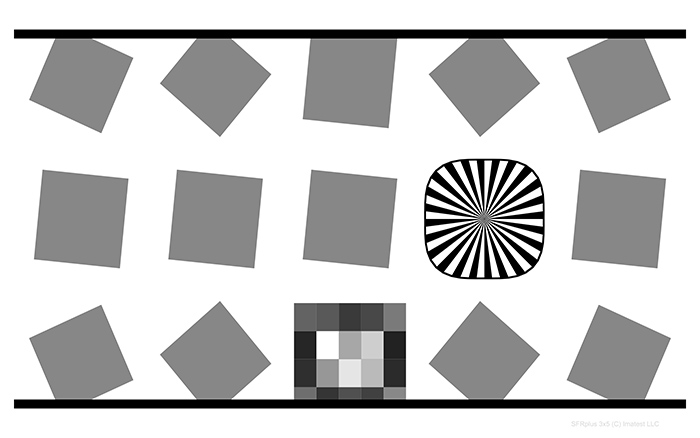I’ve been reporting on the modulation transfer function results from some lens/sensor testing that I’ve been doing. I few days ago, I show you some work that I’d done with the Nikon 70-200 f/2.8 GII ED on the Nikon D810 to the Sony 70-200 f/4 G OSS FE on a Sony a7RII. For those tests, I used autofocus. I said that I’d explain why later. It’s later, so here goes.
Imatest has a target that looks like this:
The Siemens star is fine for autofocusing, but I find a zone plate easier to use when I’m focusing manually with a sharp lens. I made a target that has both:
It turns out that the zone plate is not very useful with the 70-200, at least at 200mm at the distance that I can achieve. I use aliasing artifacts in the finder as an indication of critical focus, and I’m either too close or neither of the lenses that I’m using are sharp enough to get those artifacts.
I made a series of 16 exposures with the target centered using the Nikon 70-200/2.8 at 200mm and f/4, once with manual focusing, and once with autofocusing, both in live view. EFCS was on, the ISO was set to 100, and I dialed in a one-stop overexposure into the meter, which gave a moderately ETTR result. I developed the images in Lr with default settings except for white balancing to the background paper white.
Here’s what Imatest had to say about the MTF50 of the horizontal edge nearest the focusing target:
The top of the red bar is the average (aka mu) MTF50, in cycles/picture height. The top of the gray bar is the average plus three standard deviations (sigmas, in probability-speak). The top of the blue bar is the average minus three standard deviations. The stack on the left is for autofocus, and the one on the right is for manual focus. You can see that the average is about the same whether AF or MF is used, and that the spread is worse for manual focusing.
I did the same test with the Sony 70-200/4 on the Sony a7RII. Here’s what resulted:
Pretty much the same thing, except the numbers are lower. We’ve seen that the Sony zoom isn’t as sharp on-axis at f/4 as the Nikon lens is.
What you don’t see here it the amount of effort it took to make the af versus the mf series. To do the af series, I just set the intervalometer and sat down until the camera stopped clicking. Making the manual focusing series was a painful and time-intensive operation. I certainly don’t want to do that kind of testing anymore than I have to. It’s one thing to focus once and make 16 exposures; that’s easy. It’s another thing entirely to focus 16 times for each data set.
Since I’m talking about manual focusing, I might as well tel you about an idea that I had that turned out to be not so smart. I was looking for a target that would be optimized for use with cameras that employ focus peaking, like the Sony alpha 7s. I wanted a target that would excite a progressively larger area as focus was improved, and one that would work with lenses of differing sharpness. This is what I came up with:
Unfortunately, it didn’t work very well. My accuracy was much better with either of the other two targets.





[…] this be helped by manually focusing. No, it can’t. I tested that earlier. Manual focusing is even […]